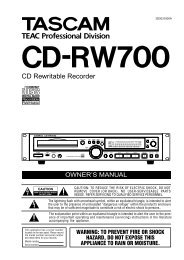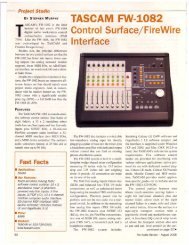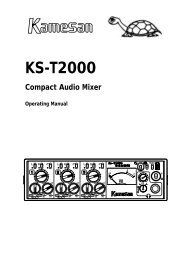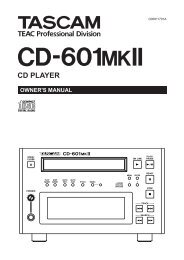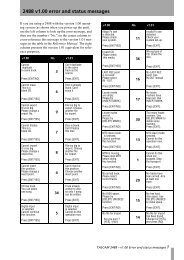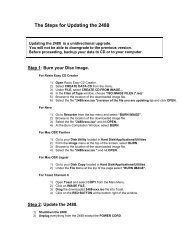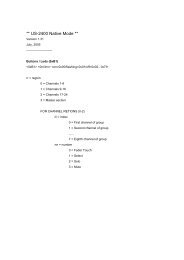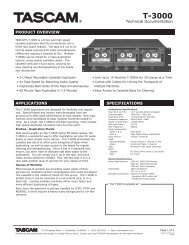Modular Multitrack Recorder - Tascam
Modular Multitrack Recorder - Tascam
Modular Multitrack Recorder - Tascam
Create successful ePaper yourself
Turn your PDF publications into a flip-book with our unique Google optimized e-Paper software.
Important Safety Instructions<br />
CAUTION:<br />
• Read all of these Instructions.<br />
• Save these Instructions for later use.<br />
• Follow all Warnings and Instructions marked on the audio<br />
equipment.<br />
1) Read Instructions — All the safety and operating instructions<br />
should be read before the product is operated.<br />
2) Retain Instructions — The safety and operating instructions should<br />
be retained for future reference.<br />
3) Heed Warnings — All warnings on the product and in the operating<br />
instructions should be adhered to.<br />
4) Follow Instructions — All operating and use instructions should be<br />
followed.<br />
5) Cleaning — Unplug this product from the wall outlet before cleaning.<br />
Do not use liquid cleaners or aerosol cleaners. Use a damp cloth for cleaning.<br />
6) Attachments — Do not use attachments not recommended by the<br />
product manufacturer as they may cause hazards.<br />
7) Water and Moisture — Do not use this product near water _ for<br />
example, near a bath tub, wash bowl, kitchen sink, or laundry tub; in a wet<br />
basement; or near a swimming pool; and the like.<br />
8) Accessories — Do not place this product on an unstable cart, stand,<br />
tripod, bracket, or table. The product may fall, causing serious injury to a<br />
child or adult, and serious damage to the product. Use only with a cart,<br />
stand, tripod, bracket, or table recommended by the manufacturer, or sold<br />
with the product. Any mounting of the product should follow the manufacturer’s<br />
instructions, and should use a mounting accessory recommended by<br />
the manufacturer.<br />
9) A product and cart combination should be moved with care. Quick<br />
stops, excessive force, and uneven surfaces may cause the product and cart<br />
combination to overturn.<br />
10) Ventilation — Slots and openings in the cabinet are provided for<br />
ventilation and to ensure reliable operation of the product and to protect it<br />
from overheating, and these openings must not be blocked or covered. The<br />
openings should never be blocked by placing the product on a bed, sofa,<br />
rug, or other similar surface. This product should not be placed in a builtin<br />
installation such as a bookcase or rack unless proper ventilation is provided<br />
or the manufacturer’s instructions have been adhered to.<br />
11) Power Sources — This product should be operated only from the<br />
type of power source indicated on the marking label. If you are not sure of<br />
the type of power supply to your home, consult your product dealer or<br />
local power company. For products intended to operate from battery<br />
power, or other sources, refer to the operating instructions.<br />
12) Grounding or Polarization — This product may be equipped with<br />
a polarized alternating-current line plug (a plug having one blade wider<br />
than the other). This plug will fit into the power outlet only one way. This<br />
is a safety feature. If you are unable to insert the plug fully into the outlet,<br />
try reversing the plug. If the plug should still fail to fit, contact your electrician<br />
to replace your obsolete outlet. Do not defeat the safety purpose of<br />
the polarized plug.<br />
13) Power-Cord Protection — Power-supply cords should be routed<br />
so that they are not likely to be walked on or pinched by items placed upon<br />
or against them, paying particular attention to cords at plugs, convenience<br />
receptacles, and the point where they exit from the product.<br />
14) Outdoor Antenna Grounding — If an outside antenna or cable<br />
system is connected to the product, be sure the antenna or cable system is<br />
grounded so as to provide some protection against voltage surges and<br />
built-up static charges. Article 810 of the National Electrical Code,<br />
ANSI/NFPA 70, provides information with regard to proper grounding of<br />
the mast and supporting structure, grounding of the lead-in wire to an<br />
antenna discharge unit, size of grounding conductors, location of antennadischarge<br />
unit, connection to grounding electrodes, and requirements for<br />
the grounding electrode.<br />
"Note to CATV system installer:<br />
This reminder is provided to call the CATV system installer’s attention to<br />
Section 820-40 of the NEC which provides guidelines for proper grounding<br />
and, in particular, specifies that the cable ground shall be connected to<br />
the grounding system of the building, as close to the point of cable entry as<br />
practical.<br />
Example of Antenna Grounding as per<br />
National Electrical Code, ANSI/NFPA 70<br />
ELECTRIC<br />
SERVICE<br />
EQUIPMENT<br />
NEC - NATIONAL ELECTRICAL CODE<br />
GROUND<br />
CLAMP<br />
ANTENNA<br />
LEAD IN<br />
WIRE<br />
ANTENNA<br />
DISCHARGE UNIT<br />
(NEC SECTION 810-20)<br />
GROUNDING CONDUCTORS<br />
(NEC SECTION 810-21)<br />
GROUND CLAMPS<br />
POWER SERVICE GROUNDING<br />
ELECTRODE SYSTEM<br />
(NEC ART 250. PART H)<br />
15) Lightning — For added protection for this product during a lightning<br />
storm, or when it is left unattended and unused for long periods of time,<br />
unplug it from the wall outlet and disconnect the antenna or cable system.<br />
This will prevent damage to the product due to lightning and power-line<br />
surges.<br />
16) Power Lines — An outside antenna system should not be located in<br />
the vicinity of overhead power lines or other electric light or power circuits,<br />
or where it can fall into such power lines or circuits. When installing<br />
an outside antenna system, extreme care should be taken to keep from<br />
touching such power lines or circuits as contact with them might be fatal.<br />
17) Overloading — Do not overload wall outlets, extension cords, or<br />
integral convenience receptacles as this can result in risk of fire or electric<br />
shock.<br />
18) Object and Liquid Entry — Never push objects of any kind into<br />
this product through openings as they may touch dangerous voltage points<br />
or short-out parts that could result in a fire or electric shock. Never spill<br />
liquid of any kind on the product.<br />
19) Servicing — Do not attempt to service this product yourself as opening<br />
or removing covers may expose you to dangerous voltage or other hazards.<br />
Refer all servicing to qualified service personnel.<br />
20) Damage Requiring Service — Unplug this product from the wall<br />
outlet and refer servicing to qualified service personnel under the following<br />
conditions:<br />
a) when the power-supply cord or plug is damaged.<br />
b) if liquid has been spilled, or objects have fallen into the product.<br />
c) if the product has been exposed to rain or water.<br />
d) if the product does not operate normally by following the operating<br />
instructions. Adjust only those controls that are covered by the operating<br />
instructions as an improper adjustment of other controls may result in<br />
damage and will often require extensive work by a qualified technician to<br />
restore the product to its normal operation.<br />
e) if the product has been dropped or damaged in any way.<br />
f ) when the product exhibits a distinct change in performance _ this indicates<br />
a need for service.<br />
21) Replacement Parts — When replacement parts are required, be<br />
sure the service technician has used replacement parts specified by the<br />
manufacturer or have the same characteristics as the original part.<br />
Unauthorized substitutions may result in fire, electric shock, or other hazards.<br />
22) Safety Check — Upon completion of any service or repairs to this<br />
product, ask the service technician to perform safety checks to determine<br />
that the product is in proper operating condition.<br />
23) Wall or Ceiling Mounting — The product should be mounted to a<br />
wall or ceiling only as recommended by the manufacturer.<br />
24) Heat — The product should be situated away from heat sources such<br />
as radiators, heat registers, stoves, or other products (including amplifiers)<br />
that produce heat.<br />
3



